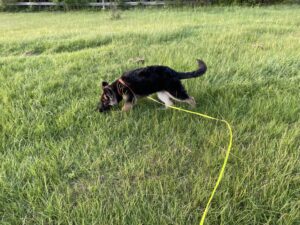Crate training & confinement training is an essential skill for all dogs. Of course, young puppies can benefit from confinement training to help with house training. Even the best behaved adult dogs may need to be crated at some point – at the vet, during a boarding situation, during an emergency or evacuation, or as part of recovery after an injury or surgery. In all these situations, we need our dogs to not only willingly enter a crate but also stay inside one calmly without panicking or hurting themselves.
This article will be helpful for two situations:
- Your puppy or dog has never experienced a crate.
- Your puppy or dog has experienced a crate, and has some kind of negative association.
The difference between the two situations above is going to be the pace you work at and the things you focus on. Settling calmly in a crate requires several different skills, and different dogs will find that some of these come easier than others. To be considered an A+ crate student, your dog must:
- Calmly enter the crate on cue.
- Quickly and easily lay down and sleep within 5-10 minutes of being crated.
- Stay calm while moderately interesting things happen outside the crate.
- Stay calm for extended periods, typically up to 4 hours.
- Stay calm while their owner leaves.
- Not spin, bark, dig, whine, vocalize, pace, pant or drool excessively, shred inappropriately, chew crate bars, or other behaviors that indicate stress.
Of course, not all dogs have these skills! Some dogs need their crate to be covered in order to settle, other dogs can be in a crate but can’t tolerate their owner leaving.
There are three main emotional aspects of crate training for dogs: confinement, separation, and distraction neutrality.
While you are re-building or building your crate training skills, you may still need to use a crate for management. Use a different crate, in a different location, for their management. This is your “throw-away” crate. As much as you can, reduce the stress of crating for them. However, don’t poison your brand new crate with bad feelings by using it before they’re ready.
Building Confinement Neutrality
If your dog already has a negative association with their current crate, use a different crate, or put their old crate in a new location.
- Place your dog’s crate in a location they have free access to. Leave the door open. For highly sensitive dogs, consider removing the door or securing it so it cannot close behind them.
- Make the crate cozy and comfortable. Use something like a Primo Pad or a soft bed to make it comfy.
- Use some free treats to build positive feelings. (Note: these are free – your dog doesn’t have to do anything to earn them!) You can even be sneaky with this – finding surprise treats can be even more powerful than watching someone place them.
- First, place free treats around the outside of the crate.
- If your dog happily eats those, try placing some in the doorway of the crate.
- If your dog happily eats those, try placing some just inside the crate.
- If your dog happily eats those, try scattering them around the inside of the crate.
- When your dog is happy exploring the crate, toss a few treats inside for them. Before they have a chance to leave, toss some more in. Keep rewarding them as long as they stay in place.
- Close the door for a half second, then immediately open it and feed them. (If they try to bolt, let them! That means we went too fast. Try only touching the door next time.)
- Increase how much time you can hold the door closed, continuing to feed heavily.
Building Separation Neutrality
- Start working on separation neutrality outside the crate. My favorite skill for this is mat game.
- With your dog on their mat, take a half-step away and return. Mark and reward.
- Slowly add distance at a rate they are comfortable with.
- If they get off their mat, reset them and make your next rep easier.
- When your dog is really good at this on their mat, repeat this with their crate. Leave the door open at first.
- When your dog is really good at this with their crate door open, repeat this with the door closed.
- If they stand up, or show any stress signals, reset and make your next rep easier.
- If they show any stress signals, you may need to open the crate door and repeat your next rep with the door open.
Building Distraction Neutrality
- Start working on distraction neutrality outside the crate. My favorite skill for this is mat game.
- Practice mat game while normal life distraction happens around them. Place their mat where their crate is. Here are some examples to work on:
- Prepare a meal with them on their mat
- Interact with your other dog(s)
- Play with your other dog(s)
- Watch TV
- Do laundry
- Exercise
- Clean the house
- If your dog gets up, reset them and try again. If they get up twice in a row, you may have made things too hard! Take a step back in difficulty. A third reset often means it’s time to wrap up for the day.
- After they get good at this on their mat, practice with the crate door open!
- Once they’re good at this with the crate door open, try it again with the crate door closed!



